Clear Skies
Clear Skies in Rhode Island
Highlights of Clear Skies in Rhode Island
 Rhode
Island sources would reduce emissions of NOx by 3% by 2020 due
to Clear Skies (no SO2 or mercury emissions are projected).
Rhode
Island sources would reduce emissions of NOx by 3% by 2020 due
to Clear Skies (no SO2 or mercury emissions are projected).
- The health benefits in Rhode Island would total approximately
$310 million under Clear Skies. In the New England region, the
benefits include 500 fewer premature deaths (290 fewer premature
deaths under the alternative estimate) and 860 fewer hospitalizations/emergency
room visits each year.
- In addition, Rhode Island would receive environmental benefits,
including reductions of nitrogen deposition to Narragansett Bay
and surrounding watersheds by up to 20%. In addition, improved
visibility for Rhode Island residents who visit National Parks
and Wilderness areas nationwide would be $41 million each year
by 2020.
- Clear Skies does not significantly impact electricity prices. With or without Clear Skies, electricity prices in the electricity supply region that includes Rhode Island are expected to remain below 2000 prices.
Clear Skies: An Innovative Approach to Improving Human Health and the Environment
Why Clear Skies?
- Air quality has improved, but serious concerns persist
- Rhode Island’s citizens suffer ill effects from air pollution, including asthma attacks and premature death
- Electricity generation sector remains a major emissions source
- Very cost-effective to control the power sector, relative to other sources
- Sources are concerned about upcoming complex and burdensome
regulations
Advantages of the Clear Skies Approach
- Guarantees significant nationwide emissions reductions –
beginning years before full implementation
- Regional sources would substantially reduce emissions of
SO2, NOx and mercury
- Delivers dramatic progress towards achievement of critical health and environmental goals
- Regional sources would substantially reduce emissions of
SO2, NOx and mercury
- Uses proven, market-based flexible approach with incentives
for innovation
- Recognizes environmental needs as well as industry constraints,
allowing industry to better manage
its operations and finances while lowering risks to the public
- Sources are projected to install pollution controls to enable continued reliance on coal
- Recognizes environmental needs as well as industry constraints,
allowing industry to better manage
- Increases certainty across the board for industry, regulators, and consumers
Under Current Clean Air Act Power Plants Would Face a Complex Set of Requirements
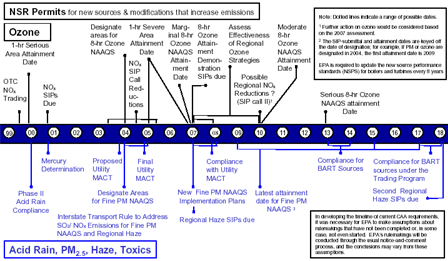
For a larger image, click here.
Clear Skies Sets a Firm Timeline for Emission Reductions
| The existing Title IV SO2 cap-and-trade program provides an incentive and a mechanism to begin reductions upon enactment of Clear Skies years before regulatory action under the current Act. |
2004: The NOx SIP call (summertime NOx cap in 19 Eastern States + D.C.)
2008: Clear Skies NOx Phase I (2.1 million ton annual cap assigned to two Zones with trading programs)
2010:
- Clear Skies Hg Phase I (26 ton annual cap with a national trading program)
- SO2 Phase I (4.5 million ton annual cap with a national trading program)
2018:
- Clear Skies NOx Phase II (1.7 million ton annual cap assigned to two Zones with trading programs)
- Clear Skies Hg Phase II (15 ton annual cap with a national trading program)
- Clear Skies SO2 Phase II (3.0 million ton annual cap with a national trading program)
Emissions in Rhode Island under Clear Skies
|
Emissions in Rhode Island (2020):
There are no coal-fired power plants in Rhode Island |
Emissions: Current (2000) and Existing Clean Air Act Regulations (base case*) vs. Clear Skies in Rhode Island in 2010 and 2020 -Sulfur dioxide and Nitrogen Oxide
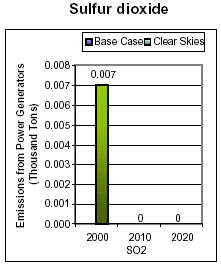
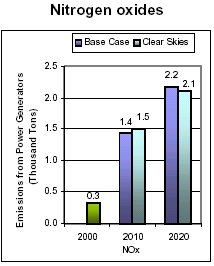
Note: The base case using IPM includes Title IV, the NOx SIP Call, NSR settlements, and state-specific caps in CT, MA, MO, NC, NH, TX, and WI. It does not include mercury MACT in 2007 or any other potential future regulations to implement the current air quality standards or other parts of the Clean Air Act. Base case emissions in 2020 will likely be lower due to state and federal regulatory actions that have not yet been promulgated.
Clear Skies Health and Air Quality Benefits in Rhode Island
Improve Public Health
| By 2020, Rhode Island would receive approximately $310 million in annual health benefits from reductions in fine particle and ozone concentrations alone due to Clear Skies (see note 1). |
Throughout the New England region, reduced ozone and fine particle
exposure by 2020 would result in public health benefits of:
- approximately 500 fewer premature deaths each year (see note 1)
- approximately 320 fewer cases of chronic bronchitis each year
- approximately 1,100 fewer non-fatal heart attacks each year
- approximately 860 fewer hospital and emergency room visits each year
- approximately 57,000 fewer days workers are out sick due to respiratory symptoms each year
- approximately 4,600 fewer school absences each year
Reduced mercury emissions would reduce exposure to mercury through consumption of contaminated fish, resulting in additional, unquantified benefits to those who eat fish from Rhode Island's lakes and streams.
Help Maintain Health-Based Air Quality Standards (see note 2)
- Currently, all counties in Rhode Island attain the fine particle
standard; all but 3 counties currently attain the 8-hour ozone standard.
- Under existing programs:
- Providence and Washington Counties (population 750,000) would be brought into attainment with the ozone standard by 2010
- Kent County (population 170,000) would be brought into attainment by 2020.
- Clear Skies would further reduce concentrations of ozone and fine particles throughout Rhode Island.Help Maintain Health-Based Air Quality Standards
Emission Reductions under Clear Skies
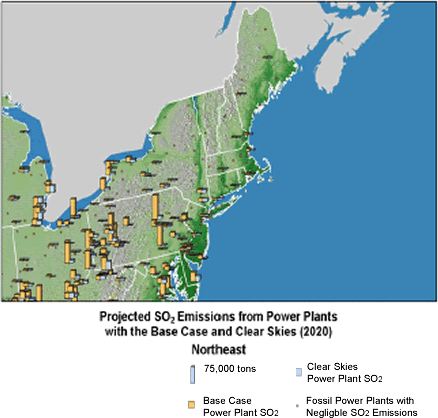

Note: The base case using IPM includes Title IV, the NOx SIP Call, NSR settlements, and state-specific caps in CT, MA, MO, NC, NH, TX, and WI. It does not include mercury MACT in 2007 or any other potential future regulations to implement the current air quality standards or other parts of the Clean Air Act. Base case emissions in 2020 will likely be lower due to state and federal regulatory actions that have not yet been promulgated. Emissions projected for new units in 2020 are not reflected.
Clear Skies Environmental Benefits in Rhode Island


Clear Skies Would Provide Substantial Environmental Benefits in Rhode Island
In comparison to existing programs,
- Visibility would improve perceptibly throughout Rhode Island.
- The value of improved visibility for Rhode Island residents
who visit National Parks and Wilderness areas nationwide would
be $41 million each year by 2020.
- Nitrogen deposition to Narragansett Bay and surrounding watersheds
would be reduced by up to 20% beyond what is expected under the
Base Case.
- Sulfur deposition, a primary cause of acid rain, would decrease by 15-30%.
- Mercury deposition would decrease by up to 5% across the state.*
* These results are based on modeling the Clear Skies mercury cap without the safety valve.
Electricity Generation in Rhode Island under Clear Skies
|
 |
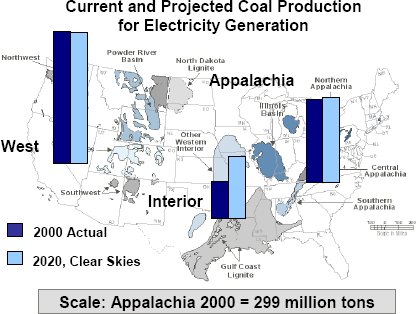
Electricity Prices in Rhode Island under Clear Skies
|
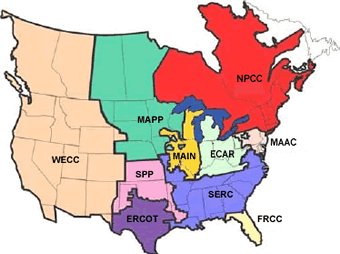
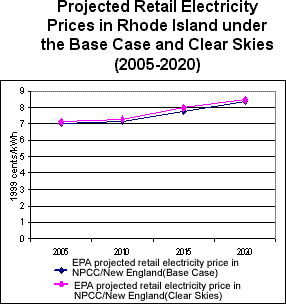
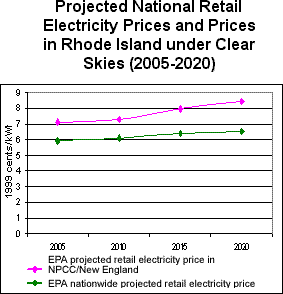
|
In 2000, the average retail electricity price in Rhode Island was approximately 9.02 cents/kWh, which was above the average national retail price of approximately 6.7cents/kWh. |
Note: The base case using IPM includes Title IV, the NOx SIP Call, NSR settlements, and state-specific caps in CT, MA, MO, NC, NH, TX, and WI. It does not include mercury MACT in 2007 or any other potential future regulations to implement the current air quality standards or other parts of the Clean Air Act. Base case emissions in 2020 will likely be lower due to state and federal regulatory actions that have not yet been promulgated.
Costs and Benefits in New York under Clear Skies
|
Clear Skies….
|
Benefits Outweigh the Costs
- In Rhode Island, economic modeling projects that the cost of generating electricity, of which a component is the cost of installing and operating pollution controls, is less under Clear Skies than under the base case as power production shifts within the region to enable the power sector to comply in the most cost-effective manner. Total annual health benefits in 2020 for Rhode Island are projected to be $310 million.
- Nationwide the projected annual costs of Clear Skies (in $1999) are $4.3 billion in 2010 and $6.3 billion in 2020; the nationwide benefits of Clear Skies are expected to be over $113 billion annually by 2020.
- An alternative estimate projects annual health benefits totaling $23 billion.
Note: Costs include capital costs, fuel, and other operation and maintenance costs (both fixed and variable) associated with the achievement of the emissions caps in the legislation (for example, the installation and operation of pollution controls). These state-level production costs are estimates; they do not account for the costs associated with the transfer of electricity across regions, nor the costs or savings that could be associated with allowance movement between sources.
Notes on EPA's Analysis
- The information presented in this analysis reflects EPA's
modeling of the Clear Skies Act of 2003.
- EPA has updated this information to reflect modifications:
- Changes included in the Clear Skies Act of 2003.
- Revisions to the Base Case to reflect newly promulgated rules at the state and federal level since the initial analysis was undertaken.
- The Clear Skies modeling results presented include the
safety valve feature
- EPA has updated this information to reflect modifications:
- This analysis compares new programs to a Base Case (Existing
Control Programs), which is typical when calculating costs and
benefits of Agency rulemakings.
- The Base Case reflects implementation of current control
programs only:
- Does not include yet-to-be developed regulations such
as those to implement the National Ambient Air Quality
Standards.
- Does not include yet-to-be developed regulations such
as those to implement the National Ambient Air Quality
Standards.
- The EPA Base Case for power sector modeling includes:
- Title IV, the NOx SIP Call, NSR settlements, and state-specific caps in Vermont, Massachusetts, Missouri, Vermont, North Carolina, Texas, and Wisconsin finalized before March 2003.
- For air quality modeling, the Base Case also includes federal and state control programs, as well as the Tier II, Heavy Duty Diesel, and Non-Road Diesel rules.
- The Base Case reflects implementation of current control
programs only:

1 An alternative methodology for calculating health-related benefits projects approximately 290 premature deaths prevented throughout New England and $56 million in health benefits each year in Rhode Island by 2020.
2. Based on 1999-2001 data of counties with monitors that have three years of complete data.
|
State information based on EPA's modeling of the Clear Skies Act of 2002 is presented here for archival reasons.
|
